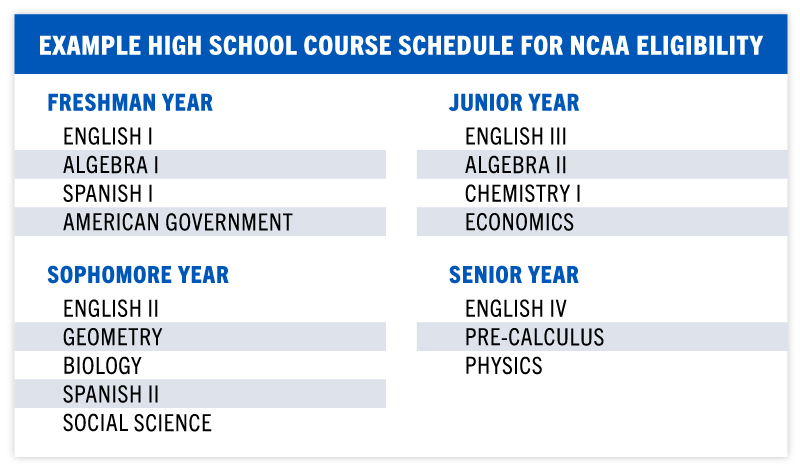The NCAA core courses requirements are part of the D1 and D2 eligibility requirements. Below we outline what you need to be eligible to compete and receive an athletic scholarship for each division level.
Quick Links
Division 1 requirements
- Graduate high school
- Earn a core course GPA pf 2.3 or higher
- Complete 16 core courses
- 4 years of English
- 3 years of math (Algebra 1 or higher)
- 2 years of natural/physical science
- 1 year must be lab science if your school offers it
- 1 additional year of English, math or natural/physical science
- 2 years of social science
- 4 additional years of English, math, natural/physical science, social science, foreign language, comparative religion or philosophy
- You must complete 10 of the core courses by the end of your junior year (before the start of your seventh semester). Seven of the 10 core courses need to be in English, math or natural/physical science. The grades in these seven courses will be “locked in,” meaning you will not be allowed to retake them to improve your grades.
Insider Tip: While there are slightly different eligibility requirements for NCAA D1 and D2, in 98 percent of the cases, if you are eligible at the D1 level, you will also be eligible at the D2 level. It is best to schedule your courses to meet the D1 requirements so you can be assured of being eligible at both division levels.
Division 2 requirements:
- Graduate high school
- Earn a core course GPA of 2.2 of higher
- Complete 16 core courses
- 3 years of English
- 2 years of math (Algebra 1 or higher)
- 2 years of natural/physical science
- 1 year must be lab science if your school offers it
- 3 additional years of English, math or natural/physical science
- 2 years of social science
- 4 additional years of English, math, natural/physical science, social science, foreign language, comparative religion or philosophy
Sample high school class schedule for NCAA eligibility
Below is a sample high school course schedule that would ensure a student-athlete was on track to meet all of the DI and DII core course requirements. These are generic course names, and they may or may not match up with the list of courses for your high school. It is important you sit down with your high school counselor and put together a similar plan with the courses that are approved for your high school.

FAQs about core courses
What are core classes?
To meet NCAA eligibility requirements to compete at the college level, athletes much complete 16 core courses (core classes) identified by the NCAA. These courses include: English 1-4, American literature, Creative Writing, Algebra 1-3, Geometry, Statistics, Biology, Chemistry, Physics, American History, Civics, Government, Comparative Religion and Spanish 1-4.
What core classes are required in college?
The core classes required in college are English, Math, Social Sciences, Humanities, and Science.
What are the core courses in high school?
Most high schools in the U.S. have a list of approved core courses with the NCAA. This list allows the NCAA to quickly evaluate an athlete’s eligibility by simply checking that the class is on the approved list and seeing what the student-athlete’s grade was in the course. Use the NCAA website to look up your high school’s NCAA-approved courses. Meet with your counselor and make sure the course plan you have matches up with the approved courses.
NCAA core courses worksheet
How do you figure out your core GPA?
If you need to check your core course GPA and make sure you are on track to meet the eligibility requirements, you will need the core course worksheet. With this worksheet, you will fill in the classes you have completed (make sure they are on the approved list for your high school) and the grade you received in the class. You can then total up the credits and grade to estimate your core course GPA and know if you are on track.
